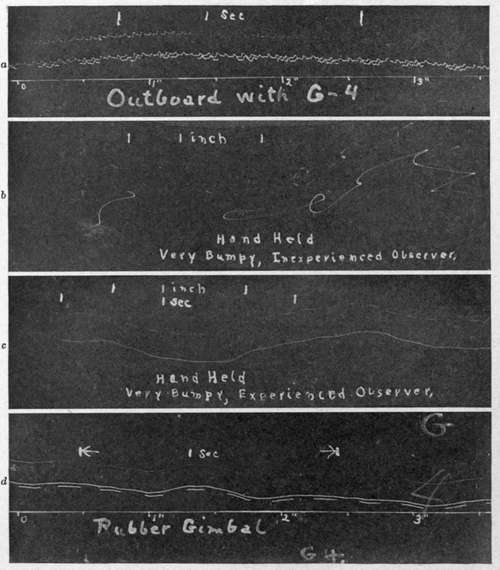Experimental Study Of Methods Of Camera Support
Description
This section is from the book "Airplane Photography", by Herbert E. Ives. Also available from Amazon: Airplane photography.
Experimental Study Of Methods Of Camera Support
Conclusive evidence as to the merits of any system of camera mounting can be obtained only under conditions that eliminate the effect of other variables which may be equally efficacious in diminishing the effects of vibration, but which have only limited application. Very brief exposures—5 second and less—will, for instance, result in good pictures with almost any condition of vibration. Hence a sharp picture offers no proof of the merits of a camera mounting unless it is known that the exposure was no shorter than the limit set by the ground speed of the plane. In fact it may be said that the chief object of studying methods of camera suspension is to increase the allowable exposure to a maximum, thus lengthening the working hours and multiplying the useful working days for aerial photography.
The most satisfactory method of test yet developed is to fly over a light or a group of lights on the ground with the camera shutter open. In the first use of this method, which originated in the English Service, such flights were made at night, but later it was found that good results could be got by placing the lights in a forest and making the tests when the sun was fairly low. One of the group of lights must be periodically interrupted, at a known rate, to furnish the time intervals.
Some characteristic "trails" obtained by this method of test are shown in Fig. 78. The first trail is that given by a camera rigidly fastened to the fuselage. The second and third show hand camera trails, made by an inexperienced and by an experienced observer, respectively. They show by comparison with the other figures that the human body is an excellent block to vibration, but in unskilled hands a poor check to rapid erratic (probably rotational) motions of the camera. The fourth is the trail given by a camera supported by gimbals bedded in sponge rubber accurately in the plane of the camera's center of gravity. Other trails are shown in the next chapter in connection with the description of practical camera mountings. Clearly the best suspension is that giving the smallest amplitude of displacement during the interval of time covered by an average exposure. It is, in fact, possible to determine from these trails the permissible exposure for any assumed permissible blurring of the image. The rigid mounting trail indicates very bad conditions, calling for literally instantaneous exposures. The center of gravity trail, at the other extreme, shows practically no limitation of exposure in so far as vibration is concerned, thus bearing out the theoretical conditions above discussed. An interesting conclusion from these experiments is that a rapidly running motor gives less harmful vibration than a slow one, although in the war it was a common practice to throttle the motor before exposing. As might be expected, the greater the number of cylinders, the shorter the period and the smaller the amplitude of the vibration.

Fig. 78. - Tests of camera mounting, made by flying over a bright light against a dark background. (a) Rigid fastening on side of plane; (6) held in the band, inexperienced observer; (c) held in the hand, experienced observer; (d) camera mounted at center of gravity on gimbals bedded in sponge rubber.
Continue to:
- prev: III. The Suspension And Installation Of Airplane Cameras. Chapter XIV. Theory And Experimental Study Of Methods Of Camera Suspension. General Theory
- Table of Contents
- next: Pendular Camera Supports
Tags
camera, lens, airplane, aerial, film, exposure, photography, maps, birdseye
